Last Saturday, I went on an adventure with Kiya, my long-time friend and editor. We drove out to western Massachusetts (about a two hour drive from where I live) for a session with New England Falconry.
Why? Writing research, of course!
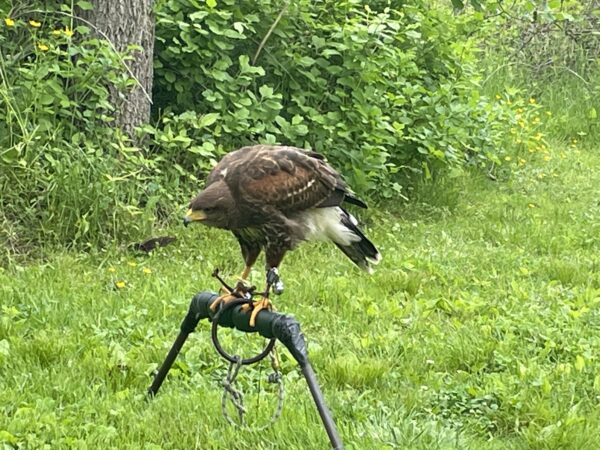
Falconry, Carillon, and upcoming delights
Lord Geoffrey Carillon is a great many things, but among them, he is a falconer. As mentioned in On The Bias, he used to fly a Eurasian eagle-owl, named Theodora (who also appears in that book). However, the sniper wound he got during the Great War (in his left shoulder joint) means that he can’t hold that much weight on his extended left hand for very long.
(Eurasian eagle-owls are about 8 pounds for females. Extremely sizeable birds.)
Since the early 1920s, he’s instead flown a merlin named Helena. Merlins are a vastly smaller bird – about 8 ounces or half a pound. (They also carry a number of different social implications.)
Then I wrote the draft of Best Foot Forward (out in November 2022) and – there is more falconry. It’s set in 1935, when Carillon is fully settled into his current life, but collaboration with Alexander Landry brings about a new set of challenges. Alexander also has a certain number of opinions about hawks and falcons, as it turns out, though largely on a more metaphorical level. Or at least less immediately physical. There’s also a scene set in the mews at Ytene.
And then there’s Ancient Trust, which is about Carillon inheriting the title in 1922 and returning to Albion and figuring out how to rearrange his life. Which of course includes a certain amount of falconry, though mostly off-screen.
All of that meant more research about falconry was in order as both those titles go into editing. And of course, the one thing that’s hard to get from books or video or other second hand sources is what the experience actually feels like. I especially wanted to get a sense of what it felt like to have a bird on the end of my arm.
Which is why we went out to western Massachusetts.
Read on for more, including plenty of great pictures!
Introduction
We began with Chris, the Master Falconer, introducing himself, and giving us about forty-five minutes of explanation about the birds, falconry, raptor biology and behaviours, and a great many fascinating related topics.
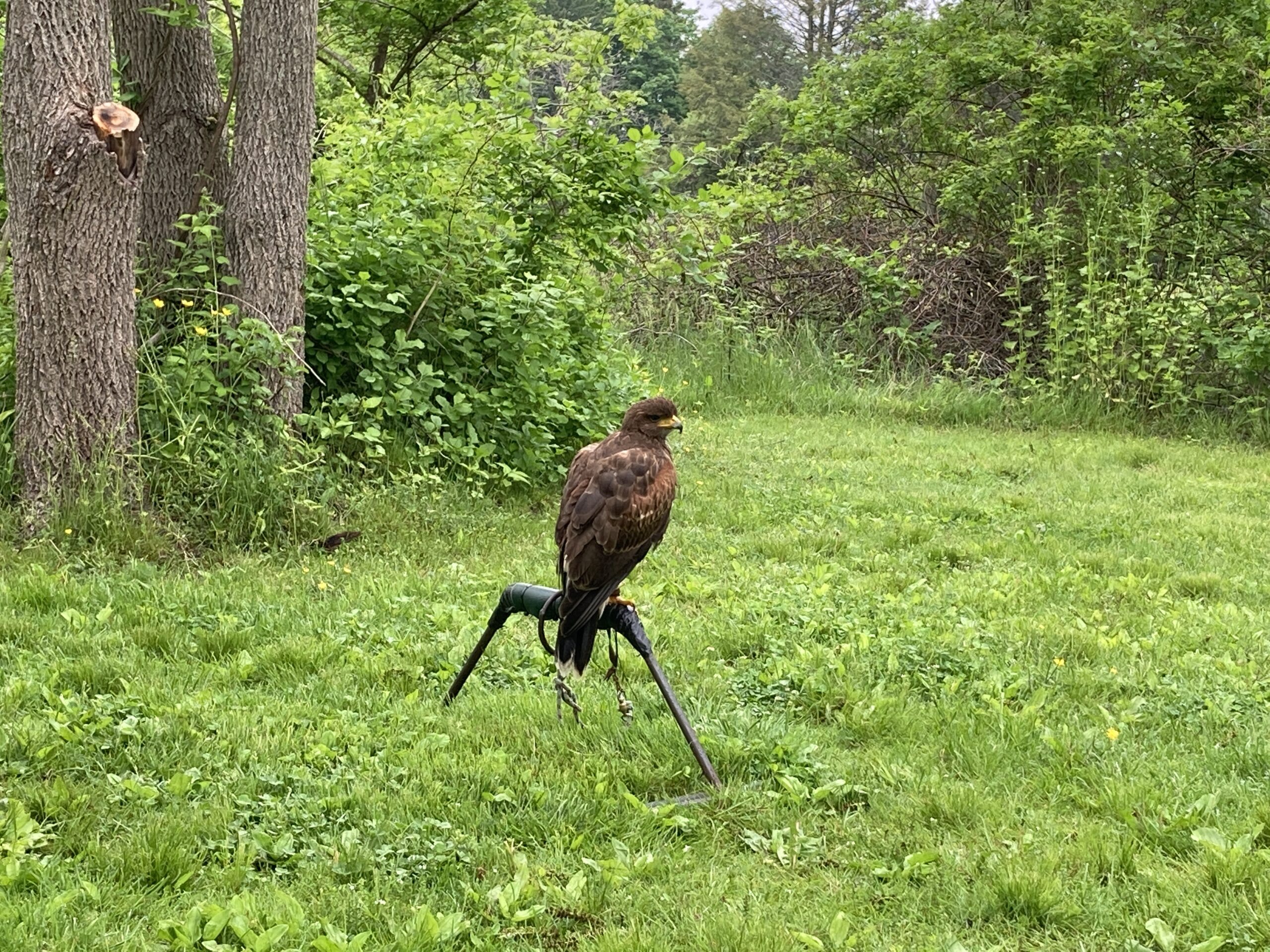
During the lecture, there were two hawks on ground perches (with us on wood benches around them). These are both Harris’s Hawks, a species that isn’t indigenous to New England, or to Europe, but whose range is in South and Central America (these days extending up into Texas and New Mexico.)
They’ve become very popular with falconers, especially for demonstrations like this, because unlike most raptors, they stay in familial groups for their lifetime, and hunt collaboratively. This means they’re a lot more open to (and relaxed) about the idea of flying to a lot of different people in a day, so long as those people provide food. (Little bits of ground meat, in this case.)
They were remarkably relaxed while we did the talking parts of this, just looking around, occasionally making hopeful noises about food, or turning around on the perch.
These two are brothers (I didn’t get a shot of both of them together), both just about a year old. I didn’t get a precise weight on them, but likely somewhere in the 1 to 1.5 pound range. They’re attached to the perches with a rope that attaches with their jesses (the lines of leather from their feet), but they didn’t try to go anywhere at all.
Chris does not name his birds, and just refers to them as the last two numbers on their identification bands, in this case “60” and “61”. He pointed out that birds are really not like dogs or cats – they are in this for the easy predictable food, and forgetting that is hard both people and birds. On the other hand, it was entirely clear how much love and respect he had for them.
Experiencing a hawk
The real joy of this, though, was the chance to have them fly to us!
The sessions run with six people who get to experience falconry, and in our case, two observers. We each got the chance to have each bird fly to us twice, which was truly amazing. It was also fascinating to see the differences in the two in terms of personality. It also helped a little – just a little – with getting over the “There is a raptor right on my hand, wow!” moment and be able to pay attention to anything else.
The way this works is that you stand in a particular spot. The bird starts off on a tree branch nearby – maybe twenty feet. You put your left hand up, in the leather glove, and the bird flies to you. Or at least that’s the theory.
(That’s me, there, from the back. And 60.)
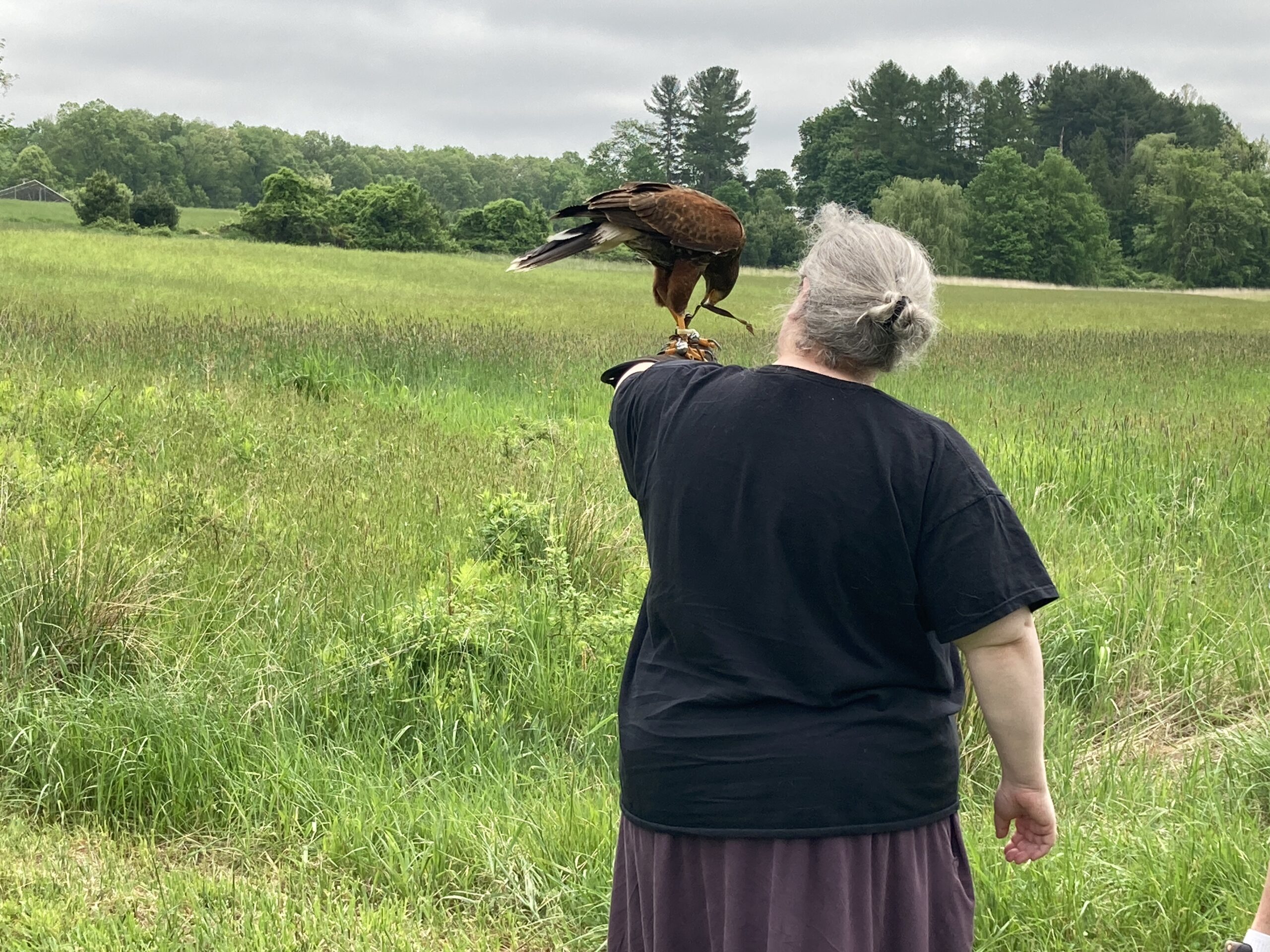
Sometimes the hawk does other things. We had several rounds of the hawk flying from the starting tree to a much taller tree, and getting lured back to the original branch. We had a couple of rounds of the hawk spotting something interesting on the ground and hopping down. There was one bit where 61 was very fascinated by something in the field we couldn’t see. (There was also an overly curious redwing blackbird wandering around.)
The feeling of having the hawk land was amazing – they’re very tidy about it, they know exactly what they’re aiming for. (That’s the bit of meat just placed on your glove.) They hang out for thirty seconds, maybe a minute or so, and then go off again, because they know how the routine goes.
(This is how I could answer the necessary research question: my arm certainly wasn’t sore after four rounds, but I could definitely feel that I’d been holding it in a more complicated postion, with weight, by the fourth round. Holding a bird there, especially a larger one, for an extended period would be quite a lot.)
Kiya managed to get some fantastic photos, so here’s a sequence of one of the birds (I think this is 61), landing, and then taking off again. (That’s Chris, with me, supervising very carefully.)
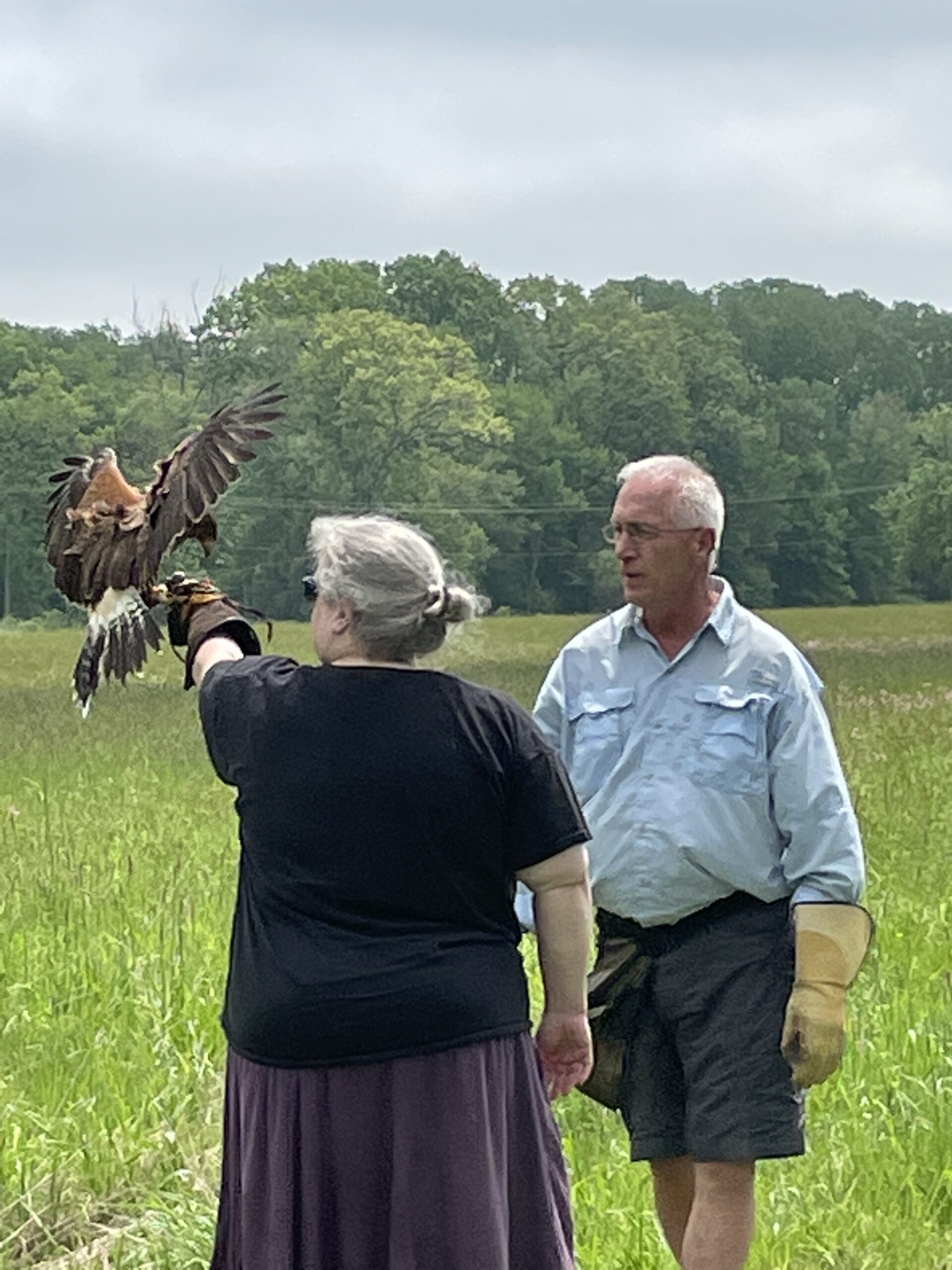
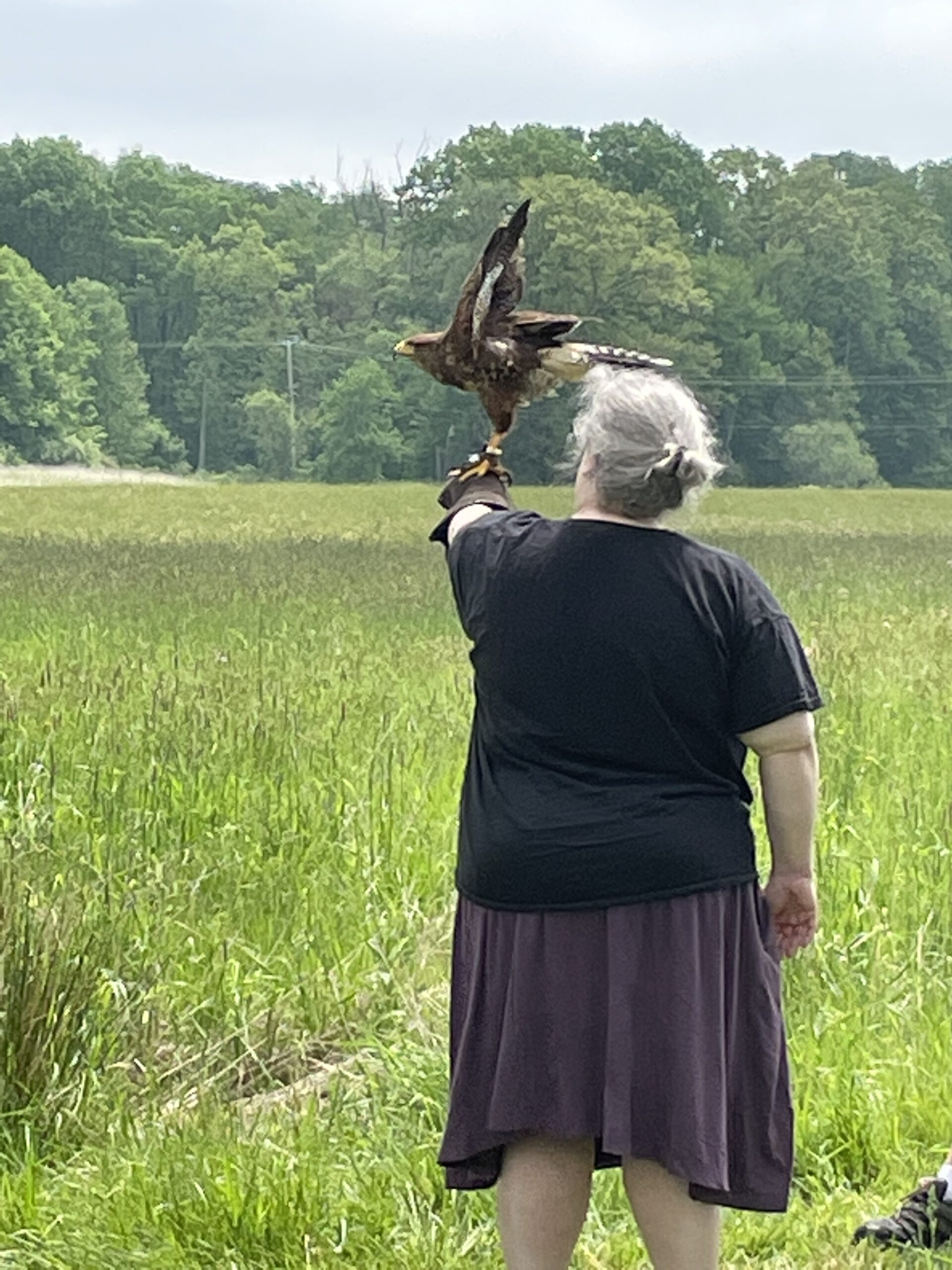

Delight and enchantment
The experience was absolutely fantastic. We’d been a little worried about the heat (it got up to over 90 in Boston and both Kiya and I are not designed for hot weather) but it didn’t warm up until we were done with the hawks and finding lunch before the drive back. I’m very excited for the ways this is going to help me make a couple of scenes more vivid, too.
If you’d like a bit more about historical falconry in the UK, English Heritage put up a fantastic 20 minute video with Raphael Historic Falconry, walking through falconry from the Romans to the Edwardians, complete with costumes and a wide range of birds.
(Also, if you’re in the New England area, drop me a note if you’d like more details about the logistics or anything of that nature. Or have other questions about this!)
